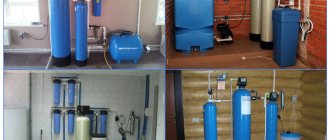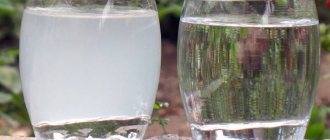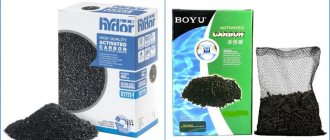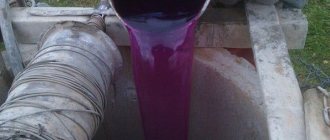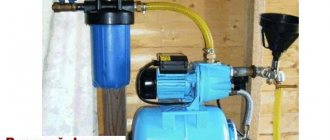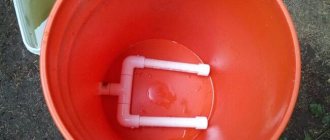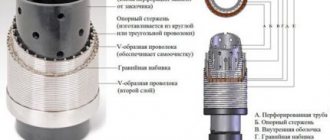For individual water supply to private houses, water intake is most often used from wells and boreholes, the quality of water in which is determined by the depth and structure of the aquifer. In common sand wells, it is necessary to have filter elements at the end of the casing, which are supplied and manufactured at the factory. But in some cases, it is more practical to make a filter for a well with your own hands, most suitable for a specific water intake source and in no way inferior to factory samples.
To do this, it is necessary to study existing methods of filtering well water and build your own system based on them. Carrying out this work does not require expensive special tools and can be done with your own hands without a lot of time if you have the appropriate components and knowledge of the technology.
Fig. 1 Types of filter casing pipes
Required Tools
Wire Gravel Hand-held corded milling cutters Drills Welding tools Tape measure Electric drill Drills Show all
If you want to drink only clean drinking liquid in a country house equipped with an autonomous water supply system, it makes sense to learn how to make a filter for a well with your own hands.
- 2 Perforated hole devices - simple and effective
- 3 How to make a wire system for water purification
- 4 Slot filters – ideal for sand wells
- 5 Gravel filter – couldn’t be simpler!
Conclusions and useful video on the topic
To select filters for purifying water from a well, you need to take into account the load on the entire system and the type of soil. Making the product yourself will save money.
If all work is carried out in accordance with the instructions, then such a device will prevent overloading of the pumping equipment and its premature breakdown. The video shows you step by step how to make the simplest perforated filter yourself. Thanks to him, the work will go quickly and without any hitches.
About filters - what does a home master need to know?
Private housing constructions within the city limits, suburban and rural dwellings are very often provided with water from autonomous systems - wells and boreholes. Such structures can be used all year round. Their main problem is clogging of the structure. It’s not difficult to get rid of it - just make a filter for the well with your own hands.
Bucket of water from a well
Such a device is a small part of the casing work string, which traps large polluting particles and passes clean liquid into an autonomous water supply system without any obstacles.
Any well filter structurally consists of the following main elements:
- Above-filter zone.
- Direct filter device.
- A special settling tank where large polluting particles are collected.
The area above the filter serves as a fastener. It makes it possible to connect the filter device to the pipe and securely fix it. The filter itself looks like a partition. It eliminates the possibility of suspended matter entering the aquifer.
Well filters not only purify water, but also protect against possible collapse of the walls of an autonomous structure, and also protect all its elements from early wear. The operating time of the water supply system and its compressor and pumping equipment increases several times if an effective filter is installed on the well.
Modern filter devices can be made from different materials and in the configuration you need. Typically, water purification devices are divided into the following groups:
- hole filters with perforation.
- wire filter systems.
- slot water purifiers.
- gravel systems.
Next, we will look at them in more detail and describe how you can make one or another filter for a well with your own hands.
Types of filters and their features
Well filters can be divided into two large groups:
- simple - with various types of holes in the bottom casing pipes;
- complex - they are a separate structure placed at the location of the bottom pipe or with filter elements mounted on the casing pipe.
In simple devices, round or slot-like holes are cut in the pipe surface; in more complex designs, wire is wound in dense rows or a fine mesh is fixed.
Perforated hole devices - simple and effective
The most affordable water purification device is a perforated filter. It is made in the form of a perforated steel pipe. Such devices are recommended for installation in wells in sand and other rocks. Perforated structures perform well when used in aquifers with unstable characteristics.
Hole water filter
Making them yourself does not cause any special problems for home craftsmen. Here it is only important to choose the correct cross-section of the pipe used, as well as the size of the holes that need to be made in it. These indicators depend on the characteristics of the land on your site and on the features of the constructed water supply system from the well.
The perforated device is made of steel pipe products that are used in the oil or geological exploration field. It is also possible to make a filter from a plastic pipe. But in this case, it is necessary to select a product that is absolutely safe for the human body. Self-manufacturing of a device for water purification is carried out as follows:
- Measure the length of the sump. Place the pipe product horizontally and apply markings on it. Note! The length of the perforated zone is taken at the rate of 25–35% of the length of the entire pipe. In this case, when installing the latter, the perforation section is located on the water intake part of the well.
- Drill holes. Make the first hole at a distance of approximately 1 m from the end of the pipe. Then drill all subsequent holes in a checkerboard pattern. The distance between them is 10–20 mm. Experts advise making holes from bottom to top at an angle of 30 to 60°. After this, you should clean (as thoroughly as possible) all the holes made, lift the pipe and tap on it to remove metal dust and shavings from the holes.
- Plug the lower end of the pipe with a wooden plug. It is advisable to cover the entire structure with a thin steel mesh. Then the filtration will occur more efficiently - the holes in the cleaning structure will practically not become clogged.
A homemade perforated filter for a well for sand or other rock is ready!
How to do it yourself?
Perforated and slotted filters
are suitable for self-production
The length of the filter part is set based on the type of soil.
For sandy soils, choose a pipe with a diameter of up to 150 mm, while the length of the filter part is 1.5-2 m.
The manufacturing process includes the following steps:
- Preparation of materials . You will need a pipe - PVC or stainless steel, mesh made of stainless steel or durable fiberglass, wire. You should also stock up on sandpaper (if you have the skill, a sanding machine), a marker and a tape measure.
- Preparing tools . To make a perforated filter, you will need a drill; for a slotted filter, you will need a grinder with a disk for fine cutting.
- Pipe preparation . Markers mark the holes (notches).
- Manufacturing . Holes are drilled using a drill according to the markings; in the second case, cuts are made with a grinder. The surface is treated with sandpaper to remove burrs. The mesh is secured to the surface of the pipe with wire.
How to make a wire system for water purification
Filters of this type are made from wire with a special profile. It is wound around the frame. Additionally, it is recommended to weld the wire to the skeleton of the structure in several places. Then the water filtration structure will be more durable. Its throughput potential depends on the wire pitch and directly on its diameter.
Wire filter parts
The wire structure is made as follows:
- Take a slotted primary filter (we will tell you how to make such a device in the next chapter). Solder 5 mm rods along its stiffening ribs.
- Next, the pipe needs to be wrapped with stainless steel wire. For these purposes, products with a cross section of no more than 2.5 mm are suitable. It is advisable to perform wire winding on a turning unit, since this operation must be done under tension. Pipe winding can also be done manually. But then get ready for quite a long and tedious job.
- Fix the wire to the rods, which are located transversely.
As you can see, it is not easy to make a wire system. You will need a lathe, a good welder, and several types of wire. Therefore, such designs are rarely made at home.
How to attach the mesh to the filter pipe?
Methods for installing a filter mesh depend on what material the filter pipe and the mesh itself are made of. There are the following fastening methods:
- Welding . This method is applicable for attaching steel mesh to a metal pipe. First, one edge of the mesh is welded, then it is tightly wrapped around the casing several times and the other edge is secured by welding.
- Soldering . The principle of its operation is practically no different from welding, but it can also be used for plastic pipes.
- Stitching . The edges of the mesh are connected to each other with a special thread or thick wire.
- Winding . A dense fishing line or wire is wound on top of the mesh placed on the pipe. The turns are made using force.
Making your own filter for a well is quite realistic and easy. The most important thing is self-confidence and the correct selection of the required material option. If you strictly follow all the instructions, the outcome of the case will definitely be positive. A properly executed filter will be in no way inferior to the factory models sold in stores.
Slot filters – ideal for sand wells
Such systems for autonomous water supply systems are characterized by high throughput potential. They are mounted on sandy soils and on rocks that are prone to collapse. The slots of such filtering devices are 80–100 times larger in area than the holes of perforated structures. Therefore, the operating efficiency of slot-hole structures is many times greater.
Slot filter for well water
To make such filters, you need to stock up on a gas cutter or milling tool and a steel pipe. The length of the slots for wells on sand and unstable soils is taken in the range of 25–75 mm, width – 3–5 mm. Important note. The slots can be arranged in a checkerboard pattern (as in a perforated filter) or in a belt pattern (in a circle).
It is advisable to cover the top of the slot system with a brass mesh with galloon or square weave. The geometric dimensions of the cells of the mesh structure are determined experimentally. Take 2-3 meshes with different parameters and sift sand through them. Choose one that allows no more than half of the sand to pass through.
Before applying and securing the mesh, stainless steel should be spirally wound onto the filter slot device. Take a wire with a cross section of 3 mm. Wind it in increments of about 2 cm and weld it to the skeleton of the structure every 45–55 cm.
Then put the mesh over the pipe and, using wire, pull it in a spiral in increments of up to 10 cm. Be sure to bend and tighten all the turns with pliers after twisting them. To increase the strength of the structure, weld the mesh. Perform this operation like this: first fix one edge of it, and then overlap the second edge onto it.
The work is completed. You have at your disposal a high-quality slot filter. It is optimal for sand wells. You can also use this design as a blank for making the wire structure described above.
Summing up
Having understood the process of manufacturing well filters, you have a general understanding of the principle of their operation and the manufacturing process. Now you are faced with another question: which filter to choose? Which of all the types suits you best? The following will help you deal with this issue.
The water must be clean!
- Pay attention to the fraction of impurities. The possibility of using a filter with a simple design will depend on it.
- Is there a “final” filter? This refers to a filter that is installed at the output. If it is missing, then the well filter must be very reliable.
- Also take into account the size of the particles being passed through.
- Use exclusively metal as the material for the pipe. Although plastic is cheaper, you will have a lot of problems when connecting a metal grate to such a pipe.
- If you have a choice between stainless steel and regular metal, always choose stainless steel. For many this will not be a new thing, but still some people do not attach much importance to this material. It can last you much longer under the influence of even the strongest minerals in the earth.
Finally, I would like to note the following: under no circumstances even try to save money on making a filter for a well. The water must be clean.
General information
Metal mesh filtration devices
A galloon-weave well filter, made of metal material, is considered a classic option for arranging a filter. Its quality has been tested over many decades. The material is strong and durable; you should choose a mesh that has optimal characteristics for operation.
Attention! Nets with this type of weaving were invented in the fifties of the twentieth century. They were specially developed to purify water from large particles. The mesh is a kind of fabric, based on strong wire with cells of zero size.
A distinctive property of the mesh is the type of weaving: the base is made of a material that is thicker than the main material - “weft”. Filtering abilities are imparted due to special weaving. Cleaning occurs evenly, while the mesh has a high level of throughput.
Metal mesh marking
The filter mesh has many varieties, each type can be used in certain conditions:
1. The designation P 64, P 73 and more indicates that the mesh can cope with cleaning sand, similar to dust, or in the form of small grains. The marking shows that this material has the smallest cell diameter.
2. Designation P 60 is used for sources with impurities in the form of fine-grained sand, without dusty type.
3.P 56 is considered a universal option if there is a source of small sand particles or medium diameter in the water.
4.P 48 are suitable for sources with large sand inclusions.
Which sand particles are equated to a certain fraction
Many builders are interested in how sand is divided into fractions depending on the size of the sand grains. The following components are distinguished:
1. sand particles with a diameter of 0.1 - 0.26 millimeters are classified as fine-grained sand. If there are dusty inclusions, the water also needs to be purified.
2. Particle sizes of 0.25 – 0.5 millimeters are referred to as the average fraction size. This option is the most common.
3. Particles of 0.5 - 1.0 millimeters or more are classified as large sand. It is easiest to purify water from it.
To measure the diameter of a grain of sand yourself, you will need a magnifying glass with graph paper. Well sand is poured onto the paper and the particles are examined through a magnifying glass. Whatever size grains of sand predominate, this fraction includes sand from wells.
Attention! The preferred option for a well is a stainless steel mesh; the material does not corrode from water, without releasing any impurities into it.
When buying a mesh, you should check the high quality of the product so that the water is filtered well. For the mesh, materials of increased strength and anti-corrosion must be used; during their manufacture, the technology in accordance with GOST 3187 - 76 must be followed. The thickness of the wire is indicated on the marking.
Advantages of metal filter meshes
Metal meshes have many positive characteristics. These include:
1.wide range of materials that can be used in different soils.
2.high degree of filtration and mesh throughput.
3.nets are durable because the material is resistant to negative factors.
4.the mesh does not tear and is resistant to deformation.
Attention! When soldering the filter with your own hands, you can use solder with tin; lead cannot be used, because it should not get into the water.
Synthetic mesh
Nets made from this material appeared not so long ago, but have become popular among buyers because the material has special properties. These include:
1. synthetic mesh does not form blockages or siltation due to the smoothness of the surface. Sand cannot cling to it.
2.resistant to corrosion without releasing impurities into the liquid.
3.The filter mesh has a high throughput rate.
4.mesh costs less than metal products.
Meshes made of synthetic materials are made in accordance with technical specifications, and not GOST, like metal ones. Each enterprise develops its own production technology. It is better to purchase nets from well-known brands.
Types of Well Filters
The main element for a water well is a filter. The duration of trouble-free operation of the well, its size and constant flow rate depend on how correctly it is selected. This means that filters need to meet certain requirements:
- The devices must provide, with small sizes, maximum throughput and minimum hydraulic resistance, which means the largest amount of water taken.
- Be resistant to electrochemical and chemical corrosion and have no sediment falling out of the water.
- The materials from which the elements are made must comply with all sanitary standards.
- The price of the filter should be reasonable.
An important characteristic of the filter is its duty cycle - the ratio of the entire area of the holes to the entire working area of the device. The flow rate or water yield of the well directly depends on this value. Types of well filters:
- Slotted.
- Lamellar.
- Wire.
- In the form of a grid.
- Glued gravel.
- For high pressure, sprayed, made of polyethylene or polypropylene.
- Volumetric.
In addition, the role of a filter can be played by fine gravel, which is placed around its own filter. It is done during the construction of a well. Of two wells, with other conditions being equal, a device with a larger filter area will have a higher water yield. To achieve this, you can increase the filter diameter or its length.
Well construction
Aquifers are found among loose rocks such as sand and limestone. The flow contains many suspended particles that must be removed before entering the casing. A sand well with a depth of 20-40 m is most widespread among owners of suburban areas. Its service life is 10-15 years, but it can be extended thanks to proper maintenance.
The filter is located at the lowest point of the casing. It prevents large and small particles from getting inside. The choice of protective structure depends on their size. When pumping liquid with a large amount of impurities, borehole pumps overheat and wear out in a short time. The greater the proportion of sand in the water, the faster the submersible units will need to be replaced.
Advice. When constructing a sand well, it is recommended to additionally use pre-filtration, consisting of a layer of gravel or crushed stone poured between the walls of the shaft and the casing.

